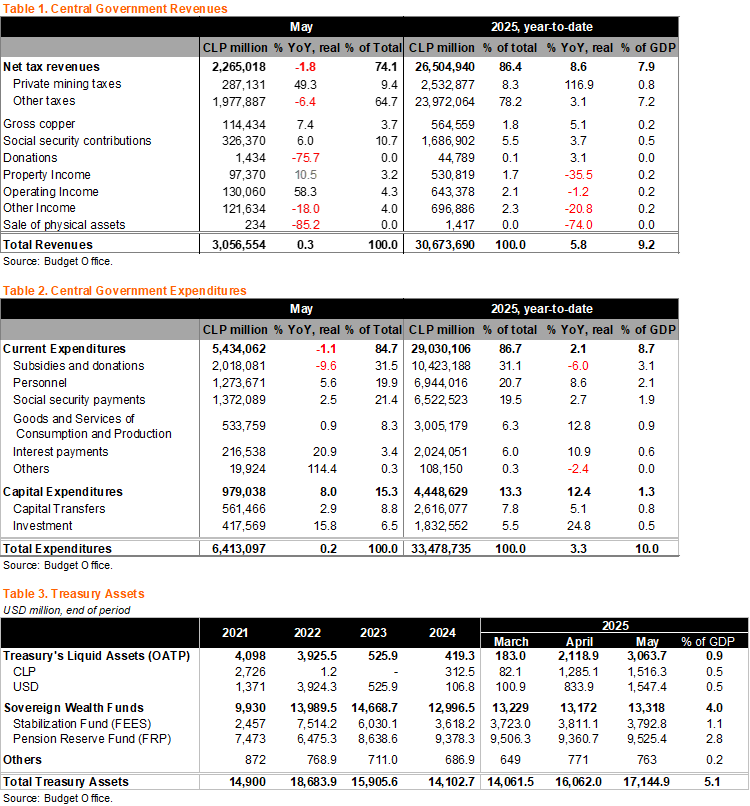May is an important month in Chile’s fiscal dynamics, considering that revenues nose-dive on the back of the Annual Tax Season that begins in April.
The Central Government’s real revenues rose by 0.3% YoY in May, on the back of the 8.0% rise in April. Cyclically-related real revenues (tributación resto contribuyentes, comprising roughly 80% of total revenues) slipped again at the margin (-6.4% YoY in May, from -2.2% in April), yet was essentially in line with our forecast (see chart). In contrast, mining-related revenue continues to outperform, reflecting the first full-year of the new mining royalty law, elevated copper prices, and greater copper production. Despite the sustained support from mining-related payments, total real revenues accumulated in the year through May have only increased by 5.8% YoY (6.4% in April), below the MoF’s annual 9.0% forecast.
Spending slowed in May. Real spending in the month rose by 0.2% YoY, with current expenditure falling by 1.1% YoY, driven by a decline in subsidies in education. Capital expenditures, in contrast, rose by 8.0%. Current expenditure through May has increased by 2.1% YoY, accumulating 41.8% of the annual budget, like in 2024 (41.9%). Capital expenditures increased by 15.5% YoY in April, mainly due to an increase in capital transfers. Capital expenditure has risen by 12.4% YoY through May, taking this component’s expenditure to 34.0% of the annual budget, the fastest execution since 2009, and well above the previous two years (25.4% in 2024, 19.8% in 2023). The MoF appears to be frontloading spending in capital expenditure again. After rising by 3.3% YoY through May, expenditure will have to slow further in the year if the MoF plans on achieving its annual spending forecast of 2.3%.
As is usually the case, May’s fiscal balance swung back to a deficit, this time of 1% of GDP, similar to the 1.1% of April 2024. Over the past few years, May has recorded the greatest monthly fiscal deficit, due to returns in the context of Tax Season. The cumulative fiscal balance through May fell to a deficit of 0.8% of GDP, a slightly smaller deficit than the 1.1% through May in 2024.
The 12-month rolling fiscal deficit remained unchanged at 2.6% of GDP in May. On a 12-month moving average basis as of the end of May, the central government’s revenues reached 21.8% of GDP, and expenditures 24.4% of GDP, leading to a cumulative deficit of 2.6% of GDP, improving from the 3.8% of GDP from a year earlier. We expect a gradual narrowing of the deficit, primarily due to an improvement in revenues.
Liquid assets at the Treasury edged up again in May. Despite the seasonal May deficit, cash levels at the Treasury (Otros Activos del Tesoro Público ) were supported by gross debt issuance (roughly USD1.3bn in May). Liquid assets in the Treasury rose to USD3.1 billion in May (from USD2.1bn in April), above May 2024’s level (USD533 million). Cash buffers appear to be improving, a welcome development. AUM in the sovereign wealth funds were little changed, likely reflecting valuation effects. The Stabilization Fund (FEES) reached USD3.8 billion, and the Pension Reserve Fund (FRP) was up slightly, to USD9.5 billion. We expect withdrawals totaling up to roughly USD900 million by the end of the year from the FRP to finance a loan to the social security fund, as part of the pension reform implementation.
Our take: The persistent strength in mining-related revenues is unlikely to compensate for the underperformance of non-mining revenues. This year’s fiscal consolidation forecast rests on additional spending restraint and continued revenue improvement. We forecast a nominal deficit of 2.0% of GDP this year. We believe that the MoF will continue with its USD16 billion annual debt issuance plan, despite improving cash levels at the Treasury. The Budget Office will release June’s fiscal data on July 31. The next Public Finance Report is scheduled for July 14.


